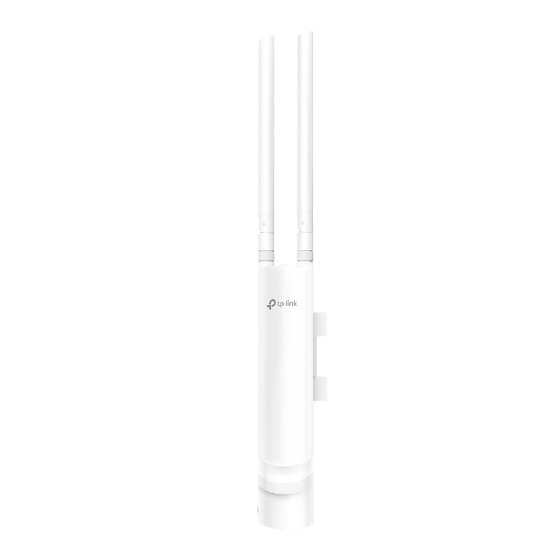Advertisement
Advertisement

Summary of Contents for TP-Link Omada EAP110-Outdoor
- Page 1 EAP110-Outdoor Installation Guide 300Mbps Wireless N Outdoor Access Point...
-
Page 2: Table Of Contents
Contents Overview Typical Network Topology Lightning and ESD Protection Hardware Installation Mount EAP Connect Cables Power On Software Configuration... -
Page 3: Overview
Overview Package Contents Mounting Bracket Mounting Bracket (for EAP) (for PoE Adapter) EAP110-Outdoor Installation Guide 300Mbps Wireless N Outdoor Access Point Antennas (Qty.2) Installation Guide D3×28 Plastic Wall ST3×20 Self-tapping Passive PoE Adapter Anchors(Qty.4) Screws (Qty.4) Power Cord Waterproof Rubber Pole Mounting Strap Insert... - Page 4 Panel Layout The Panel of EAP Shielded Ethernet RESET Port LAN...
- Page 5 SYS LED Explanation LED Status Indication Flashes green twice Initialization is completed. Solid green The device is initializing or working properly . Flashes red System errors. RAM, Flash, Ethernet, WLAN or firmware may be malfunctioning. Flashes yellow Firmware update is in progress. Do not disconnect or power off the device.
-
Page 6: Typical Network Topology
Typical Network Topology Internet Router Switch EAP Controller Clients A DHCP server (typically a router) with DHCP function enabled is required to assign IP addresses to the EAPs and clients in your local network. -
Page 7: Lightning And Esd Protection
Lightning and ESD Protection Before mounting EAP, you should consider Lightning and ESD Protection to ensure safety. Proper grounding is extremely important for outdoor devices. By using a shielded CAT5e (or above) cable for connection, you can reduce the damage of ESD attacks. Grounded 3-wire Power Outlet Shielded CAT5e (or above) -
Page 8: Hardware Installation
Hardware Installation Mount EAP The EAP can be pole-mounted or wall-mounted when working independently. Option 1: Pole Mounting Step 1: Lead the end of the pole mounting strap through the back of the EAP. Step 2: Position the EAP and wrap the pole mounting strap around the pole. - Page 9 Option 2: Wall Mounting Step 1: Place the mounting bracket (for EAP) in the right position. Mark two positions for the screw holes . Drill two 6mm holes for the screws at the marked positions. Step 2: Insert the plastic wall anchors into the 6mm holes.
-
Page 10: Connect Cables
Connect Cables Step 1: Firmly grasp the rear of the interface cover and pull it downward. Step 2: Use an adequate Ethernet cable to connect the LAN port. The length of cable is up to 100m for steady power supply. Shielded CAT5e (or above) cable is recommended. -
Page 11: Power On
Power On The EAP can be powered via the provided passive PoE adapter. Connecting the PoE Adapter Connect the EAP to a Power over Ethernet (PoE) adapter as follows: Ethernet cable length up to 100m... - Page 12 Mounting the PoE Adapter (Optional) Note: To ensure the passive PoE adapter is attached most securely, it is recommended to install the adapter with the Ethernet port facing upward. Step 1: Drill two holes on the wall and insert the plastic wall anchors into the the holes.
-
Page 13: Software Configuration
Enter the admin name and password you created and click Sign In. Then you can further configure the EAP Controller. For detailed configurations, please visit http://www.tp-link.com/support to download the User Guide of EAP Controller in the download center. Option 2: Via Web Browser... - Page 14 Set up a new Username and Password for secure management purpose. Modify the wireless parameters and reconnect your wireless devices to the new wireless network. For detailed configurations, please visit http://www.tp-link.com/support to download the User Guide of EAP in the download center.
- Page 16 QR code. The products of TP-Link partly contain software code developed by third parties, including software code subject to the GNU General Public License (“GPL”). As applicable, the terms of the GPL and any information on obtaining access to the respective GPL Code used in TP-Link products are available to you in GPL-Code-Centre under (http://www.tp-link.com/en/support/gpl/).














Need help?
Do you have a question about the Omada EAP110-Outdoor and is the answer not in the manual?
Questions and answers